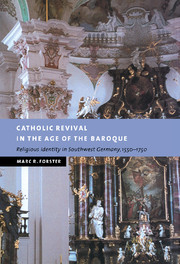Book contents
- Frontmatter
- Contents
- List of maps
- Acknowledgments
- List of abbreviations
- Introduction
- 1 The Counter-Reformation offensive, 1550–1650
- 2 The sacral landscape and pilgrimage piety
- 3 Religious practice
- 4 Clericalism in the villages
- 5 The communal church in German Catholicism
- 6 Reformers and intermediaries, 1650–1750
- Conclusion
- Bibliography
- Index
5 - The communal church in German Catholicism
Published online by Cambridge University Press: 17 July 2009
- Frontmatter
- Contents
- List of maps
- Acknowledgments
- List of abbreviations
- Introduction
- 1 The Counter-Reformation offensive, 1550–1650
- 2 The sacral landscape and pilgrimage piety
- 3 Religious practice
- 4 Clericalism in the villages
- 5 The communal church in German Catholicism
- 6 Reformers and intermediaries, 1650–1750
- Conclusion
- Bibliography
- Index
Summary
The people of Southwest Germany considered priests essential for the proper functioning of local Catholicism. They did not, however, concede control of local religion to either the official Church or to parish priests. Rural communes and town councils continued to play a strong rolein local Catholicism. The “communal church,” which dominated religious life in the century before the Reformation, did not disappear in the sixteenth century, but rather continued to be an organizing force in the following two centuries.
Popular initiative was behind much of Catholic practice, and the people most often expressed themselves through the institutions of the commune. Communes managed parish finances, oversaw the performance of the clergy, and influenced the appointment and removal of priests. They organized and promoted devotions, particularly pilgrimages, processions, confraternities, and prayer meetings. Communes also funded and supported the construction of churches and chapels and the placement of stations of the cross, new altars, and other decorations in existing churches.
The continuities between the communal church of the pre-Reformation era, as described by Peter Blickle and others, and the communal church of post-Tridentine Catholicism are striking, but not as surprising as they first appear. Thecommunal church around 1500 developed out of thebasic localism in religious life and reflected the strong role communes took in administering village life more generally. Throughout the early modern period communalism remained an organizing principle with strong roots in German villages and towns.
- Type
- Chapter
- Information
- Catholic Revival in the Age of the BaroqueReligious Identity in Southwest Germany, 1550–1750, pp. 185 - 207Publisher: Cambridge University PressPrint publication year: 2001



